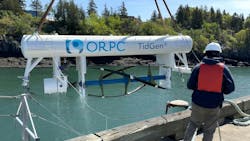Proposed Tidal and Solar Microgrids Aim to Help Outage-Heavy Maine
Energy resilience is a challenge for the state of Maine, which in 2020 experienced the highest number of outages in the U.S.
In fact, in 2023, the Penobscot Nation was out of power for five straight days.
In December 2023 and January 2024, three winter storms killed four people and yielded $90 million in damage to public infrastructure alone, according to the state climate plan.
Two microgrid projects intend to help out, one that will store solar owned by the Penobscot Nation in a battery and release it to serve critical facilities. A second microgrid project proposes using tidal power and solar to ensure the island of Eastport will weather outages.
Penobscot Nation expects about $400,000 in savings and income from microgrid
The Penobscot Nation has a long-term goal of deploying 1.2 MW to 1.4 MW of solar on rooftops – at a cost of $5 million – and store that power in batteries to provide resilience and yield economic gains, said Michael Burgess, economic and community development director at Penobscot Nation.
Right now, only one half of 1 MW of solar is operating on the reservation. The Penobscot Nation will pay for 10% of the costs of the new solar and has a federal Department of Energy (DOE) grant to pay for the rest, he said.
The tribe expects to see $400,000 a year in energy savings and about $200,000 a year in income by using the microgrid to provide grid services to the utility, Versant Power, Burgess said.
“This means a lot to the Penobscot Nation,” he said. “One of our motivations was to decrease blackouts and be in control of our own resiliency. Secondly, it will mean savings and income.”
Sunnova Energy will provide energy storage to tribe
Penobscot Nation chose Sunnova Energy to deploy a .5 MW energy storage system, along with the .5 MW per year of excess solar now produced by the tribe to create a community microgrid. The facility will serve the Penobscot community and commercial centers, the latter of which is a salmon brooding facility, he said. Salmon brooding involves salmon spawning, fertilizing eggs and caring for the eggs.
The Maine Grid Resilience Program gave Sunnova Energy a $689,000 grant valued at about half the capital cost of the initial microgrid project. The grant will be largely used to pay for power distribution and siting of the battery, said Adam Miller, vice president, microgrids at Sunnova Energy.
Sunnova will provide the other half of the capital costs through a lease or power purchase agreement with the Penobscot Nation, he said.
Why microgrid developers like Maine
Maine is an attractive market for Sunnova because a 2021 law, Microgrid Rule 3351, allows for net energy billing–aggregated net metering on multimeter properties. In this case, the community and commercial centers will be eligible for aggregated net metering, said Miller.
“We offer microgrids to stand-alone facilities but efficiencies are gained when facilities can share power and excess capacity,” he said.
“Maine is getting it right”
In addition, Maine has aims to become carbon neutral by 2045.
“Maine right now is getting it right. They are progressively thinking about achieving their sustainability goals, which is why we’ve been very focused on the state,” Miller said.
During power outages that impact the Penobscot Nation, Sunnova’s microgrid system will supply solar power stored in its battery to the two facilities, using a microgrid controller and battery energy management system, he said.
During outages, the reservation is now served by standby gas generators whose power goes to specific facilities.
The microgrid will be connected to the main grid and may supply load reduction services to the utility as one form of grid services, said Miller.
Proposed Eastport microgrid would help disadvantaged communities
A second Maine microgrid – proposed for the city of Eastport – would use solar and tidal power to provide resilience.
Eastport is located at the end of a 30-mile-long distribution line, said Nick Battista, chief policy and external affairs officer for Island Institute, which focuses on climate solutions for island communities.
When there’s an outage, electric utility Versant has to send crews to the end of the line and restoring power can be slow; sometimes it can take three to four days. While many residents have propane or gas generators, they are too expensive for disadvantaged community members, he said.
“Eastport has a high degree of socially vulnerable residents, including older folks on fixed incomes and people who need power for in-home oxygen machines,” he said. “Not everyone has generators who need them.”
Another challenge in Eastport, which is a port, is power quality. Because a diesel generator that provided voltage regulation was decommissioned 6 to 7 years ago, manufacturers in the area struggle with power quality. The microgrid could help solve that problem.
Judy Long, senior manager for communications and brand at Versant Power, said that she had heard anecdotal reports about power quality issues in Eastport a number of years ago, but the utility has made an effort to identify and improve infrastructure serving the area.
"That region actually experienced improved reliability following that work," she said.
"We are not aware of any manufacturers in the area struggling with power quality at this time, and we certainly would not ask our customers to endure power quality issues until we could potentially move forward with partners on the microgrid," Long added.
The battery for the microgrid is estimated to cost about $10 million and would include controllers and upgrades to the grid, Battista said. The city of Eastport, the state of Maine and Versant Power applied for a rural community grant from the DOE, but didn’t receive it, so they’re applying for the next round of funding. The solar for the project has already been funded.
The project might get a boost from proceedings at the Maine Public Utilities Commission that seek to allow utilities to own storage. Right now, utilities are prohibited from owning storage, which means it can’t be used for voltage regulation, said Battista.
The role of tidal power in Eastport microgrid
Under the plan for Eastport, tidal power would be a source of power for the microgrid, said Stuart Davies, CEO at ORPC, whose products generate electricity from river and tidal currents. The company is testing its products at 19 sites, including an installation for a microgrid in Alaska.
Because tides are very predictable, it’s possible to look at a tide chart and determine how much tidal power can be harnessed, he said.
Eastport is a good site for tidal power because of strong tidal velocities.
The best sites have velocities of more than 3 meters/second, said Davies.
A tidal velocity of 2 meters/second will produce eight times the electricity of a site with a velocity of 1 meter/second, he noted.
“Western Passage in Eastport, Maine, is an excellent site with its peak velocities exceeding 3 meters/second,” he said.
As water flows through the turbine it rotates the turbines’ foils. As the turbine rotates, it turns a generator that generates electricity that is brought to shore through a power cable, he explained.
Electricity from tidal power can cost as low as 30 cents/kWh in the U.K.
Locations at the end of a grid are especially good markets for tidal power because the tidal generators can provide lower-cost electricity, along with improving grid reliability.
The cost of producing power with tidal generators varies with the velocity of the tides, he said. In the U.K., recent bids for tidal power came in at electricity prices of $0.30-$0.35/kWh, he said.
“When you hear prices for wind and solar at $0.03/kWh to $0.06/kWh, that is not an apples-to-apples comparison, because those sources require in many cases 10 to 70 miles of poles and wires to bring the electricity to where there is demand,” he noted. Tidal generators, on the other hand, serve local loads and don’t require the many miles of poles and wires. And tidal energy can provide baseload power and significantly reduce emissions, when compared to diesel generators.
To Battista, the Eastport project, with its expected use of tidal power, is innovative.
It’s “cool and groundbreaking,” and can be a model as communities seek ways of embracing the clean energy transition, he said.










